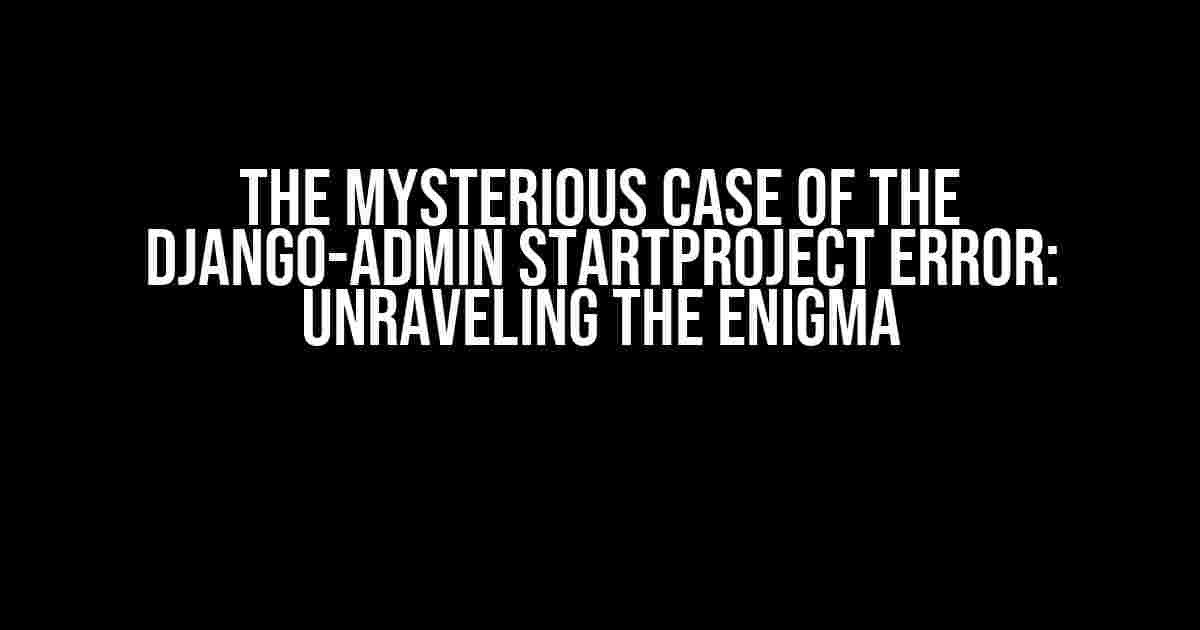Are you tired of encountering the frustrating error message “File "<stdin>", line 1 django-admin startproject core SyntaxError: invalid syntax” when trying to create a new Django project? You’re not alone! Many developers have fallen victim to this perplexing issue, but fear not, dear reader, for we’re about to embark on a journey to demystify this error and get your Django project up and running in no time.
The Anatomy of the Error
Before we dive into the solutions, let’s take a closer look at the error message itself. The most critical part of the message is the “SyntaxError: invalid syntax” bit. This indicates that there’s a problem with the syntax of the command you’re trying to execute. In this case, the command is django-admin startproject core, which should create a new Django project called “core”.
The Culprit: stdin and the Mysterious Quotes
The real culprit behind this error is the “"<stdin>"” part of the message. This is not a typo; it’s actually a hint towards the problem. “<stdin>” refers to the standard input stream, which is where the command prompt reads input from. The quotes around it suggest that the command is being interpreted as a string, rather than an actual command.
Solution 1: The Simple Fix
In many cases, the error message can be resolved by simply typing the command again, without the quotes. Yes, you read that right – sometimes, the solution is as simple as retyping the command. Try this:
django-admin startproject core
If this doesn’t work, don’t worry, we have more solutions up our sleeves.
Solution 2: The Proper Way to Run Django-Admin
Another common cause of this error is running the django-admin command inside a Python shell or terminal instead of the command prompt. To create a new Django project, you need to run the command in the command prompt or terminal, not inside a Python shell. Here’s how:
- Open a new command prompt or terminal window.
- Navigate to the directory where you want to create your new Django project.
- Type the command:
django-admin startproject core
Make sure to replace “core” with your desired project name.
Solution 3: Checking for Typos and Syntax Errors
Syntax errors can be sneaky, and sometimes, a simple typo can cause the entire command to fail. Double-check your command for any typos or syntax errors:
- Check for extra spaces or characters in the command.
- Verify that the project name is a single word (no spaces).
- Make sure the command is not surrounded by quotes or parentheses.
If you’re still encountering issues, try breaking down the command into smaller parts to identify the problem.
Solution 4: Resetting Django-Admin and Reinstalling Django
In some cases, the error might be related to a corrupted Django installation or a faulty django-admin command. Try resetting Django-Admin and reinstalling Django:
pip uninstall django pip install django
This will remove Django and then reinstall it, which should fix any issues with the django-admin command.
Solution 5: Checking for Conflicting Package Installations
Sometimes, conflicting package installations can cause issues with Django. If you have multiple versions of Django or other packages installed, try uninstalling them and reinstalling the latest version:
pip uninstall django-core pip install django
This should resolve any conflicts between different package versions.
Conclusion
The “File "<stdin>", line 1 django-admin startproject core SyntaxError: invalid syntax” error can be frustrating, but with these solutions, you should be able to overcome it and create your new Django project. Remember to:
- Check for typos and syntax errors in the command.
- Run the command in the command prompt or terminal, not inside a Python shell.
- Try resetting Django-Admin and reinstalling Django if needed.
- Check for conflicting package installations and uninstall old versions.
By following these steps, you’ll be well on your way to creating a new Django project and starting your next development adventure.
| Solution | Description |
|---|---|
| 1. Simple Fix | Retype the command without quotes |
| 2. Proper Way to Run Django-Admin | Run the command in the command prompt or terminal |
| 3. Checking for Typos and Syntax Errors | Verify the command for typos and syntax errors |
| 4. Resetting Django-Admin and Reinstalling Django | Uninstall and reinstall Django to fix corrupted installations |
| 5. Checking for Conflicting Package Installations | Uninstall conflicting packages and reinstall the latest version |
Now, go forth and conquer the world of Django development! If you have any further questions or need additional assistance, feel free to ask in the comments below.
Frequently Asked Question
Django newbies, assemble! Let’s troubleshoot a common issue that’s got you stumped.
What is the purpose of the django-admin startproject command?
The django-admin startproject command is used to create a new Django project. It sets up a basic project structure with the necessary files and directories.
What is the correct syntax for creating a new Django project?
The correct syntax is django-admin startproject projectname (e.g., django-admin startproject core). Make sure to replace “projectname” with your desired project name.
What does the error mean?
The error typically indicates that you’re trying to run the django-admin command from within a Python shell or interpreter. To fix this, exit the Python shell and run the command in your terminal or command prompt.
Why am I getting a SyntaxError: invalid syntax error?
This error usually occurs when you’re trying to run the django-admin command with incorrect syntax or within a Python script. Make sure to run the command directly in your terminal or command prompt, and double-check that you’re using the correct syntax.
How do I troubleshoot Django project creation issues?
To troubleshoot, try the following: ensure you’re running the correct command syntax, check that you’re using the latest version of Django, and verify that you have the necessary permissions to create a new project. If issues persist, check the Django documentation or seek help from online communities or forums.
